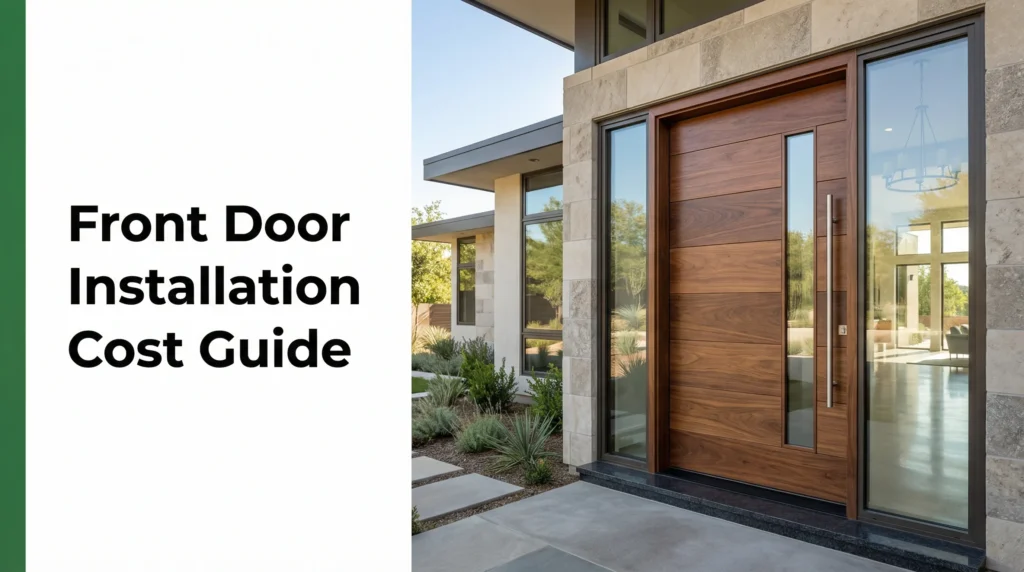Introduction
- Installing into brick, stucco, or an existing wood frame? If a nailing flange is impossible or undesirable, you can still get a tight, durable install.
- What you’ll get: A step-by-step, mistake-proof method to achieve a professional, weatherproof insert (pocket) installation—no flange required.
- Good news: This “insert” or “pocket” installation is common and totally achievable for a careful DIYer with basic tools.
Understanding Your Project: Flange vs. Flange-Free Installation
A nailing flange is a perimeter lip used in new-construction installs; a flange-free (insert) window slides into the existing frame and seals to it.
Choose flange-free when the existing frame is sound, square, and you want to preserve trim or are working with masonry.
What is a Nailing Flange?
- Nailing flange: A thin, integrated lip around a window frame used to nail or screw the window directly to sheathing. It is typically covered by housewrap, flashing, and siding in new construction.
- Flange-free (replacement) window: A unit designed to fit inside an existing window frame, fastened through the side jambs and sealed to the old frame—ideal for retrofits.
Simple visual prompt (for your own diagram):
- Left: New-construction window with perimeter flange fastened to sheathing; siding overlaps.
- Right: Insert window nested inside existing frame; screws through jambs; sealant at interior/exterior stops.
When to Choose a Flange-Free Installation
- Brick, stone, or stucco siding: Avoids cutting masonry and disturbing the WRB (weather-resistant barrier).
- Preserve trim: Keep interior/exterior casings intact for a cleaner, faster project.
- Existing frame is sound and square: The old frame must be structurally solid and reasonably square for proper sealing and operation.
Custom vinyl windows, tailored to your home. Boost comfort and curb appeal with the sizes, colors, and glass you choose.
Customize NowPre-Installation Checklist: Tools and Materials for a Perfect Seal
Answer-first: Gather everything before you start. The right sealants, low-expansion foam, and accurate measuring tools are crucial to prevent leaks and frame warping.
Tools You’ll Need
- Power drill/driver — For fastening through jambs
- Tape measure — Accurate to 1/16 inch
- Levels (2-foot and 4-foot) — Short for jambs, long for sill/overall
- Pry bar & putty knife — Gentle removal of stops and old caulk/paint
- Caulking gun — Smooth, consistent beads
- Utility knife — Scoring paint lines, trimming shims/foam
- Hammer & wood/composite shims — Composite shims resist moisture
- Safety glasses & gloves — Protection during demo and cutting
Materials You’ll Need
- Vinyl replacement window (no flange) — Ordered to precise insert dimensions
- Exterior window & door sealant — 100% silicone or advanced polymer for UV/weather resistance
- Low-expansion insulating foam — Prevents bowing; avoid high-expansion foam which can warp vinyl frames
- Galvanized or stainless steel screws — Typically 2.5″–3″ for jamb-to-framing anchoring
- Cleaning supplies — Rags and denatured alcohol for clean bonding surfaces
Note on foam: High-expansion foam exerts pressure as it cures and can bow vinyl frames, causing binding sashes and air/water leaks. Low-expansion “window and door” foam is engineered to minimize pressure.
Step 1: The Most Critical Step — Measuring Your Window Opening Accurately
Answer-first: Measure width and height in three places each; use the smallest measurement and subtract 1/4″–1/2″ to determine order size. Confirm the opening is square within 1/4″ by comparing diagonals.
How to Measure for Width
- Measure inside the existing frame at the top, middle, and bottom.
- Record the smallest measurement.
- Subtract 1/4″ to 1/2″ to determine your order width.
How to Measure for Height
- Measure the inside frame at the left, center, and right.
- Record the smallest measurement.
- Subtract 1/4″ to 1/2″ to determine your order height.
Checking for Square
- Measure diagonally from top-left to bottom-right and top-right to bottom-left.
- If the difference is ≤ 1/4″, the opening is square enough for shimming. Larger deviation may require frame repairs or a different strategy (e.g., custom sizing, deeper prep).
Pro-tip: Note sill slope. Many sills are sloped; your insert may include a sill adapter or you may need to shim to level while maintaining drainage.
Step 2: Preparing the Opening and Removing the Old Window
Answer-first: Remove sashes and stops carefully, clean all surfaces to bare, sound material, and address any rot before installing. Do not proceed over compromised framing.
Removing Old Sashes
- Score paint/caulk lines where stops meet casings with a utility knife.
- Pry off interior stop moulding gently with a putty knife and pry bar—label and save it.
- Remove lower sash, then upper sash (on double-hungs). Cut any sash cords or remove balances as needed.
- Extract parting beads and any remaining hardware or tracks. Vacuum debris.
Cleaning the Frame
- Scrape away all old caulk, paint drips, and debris from the interior/exterior stops and sill.
- Wipe bonding areas with denatured alcohol for maximum sealant adhesion.
- Confirm the sill is clean, sound, and free of protrusions.
What to Do If You Find Rotted Wood
- Identify: Probe the sill and lower jambs with an awl or screwdriver. Soft, spongy wood indicates rot.
- Minor rot: Remove loose fibers, apply wood hardener, then rebuild with epoxy wood filler. Sand flat.
- Major rot: If rot compromises structural members (sill, studs, jack studs), pause and repair or consult a pro. Installing over structural damage risks leaks and failure.
The 7-Step Installation Process for a Flawless Finish
Answer-first: Dry fit first, then seal, set, shim square, fasten through jambs, insulate with low-expansion foam, and finish with interior stops and exterior perimeter sealant.
1. Dry Fit the New Window
- Place the insert window into the opening to confirm fit.
- Look for a consistent 1/8″–1/4″ gap on all sides.
- Remove the window and make any minor adjustments (plane or sand high spots on the old frame; never cut the new unit).
2. Apply the Exterior Sealant Bead
- Lay a continuous bead of exterior window/door sealant on the exterior stop (or blind stop) where the new window’s exterior face will seat.
- Run an unbroken bead across the head and down both jambs; at the sill, leave small gaps near the outer corners as weep paths if the original system relied on drainage.
Diagram tip for reference image: Cross-section showing the old frame’s exterior stop, the new insert pressed into the bead, and the interior stop to be reinstalled later.
3. Set, Level, and Center the Window
- Press the window firmly into the sealant on the exterior stop.
- Insert shims at the sill (typically near the side jambs and under meeting rails) to level the unit and center the reveal.
- Confirm the sill is level and the frame is centered left-right with even gaps.
4. Shim for Plumb, Level, and Square
- Check level at the sill; check plumb on both side jambs.
- Add shim pairs at the side jambs: bottom, mid, and near the top. Do not shim the head jamb.
- Keep shims snug—tight enough to hold geometry, not so tight they bow the vinyl frame.
Pro-tip: Align shim locations with the manufacturer’s designated screw holes for solid fastening through shims into framing.
5. Fasten the Window
- Drive galvanized or stainless screws through factory pre-drilled holes in the jambs, through the shims, and into the framing.
- Alternate sides and re-check operation after every couple of screws—open/close sashes should move freely without rubbing.
- Typical spacing: about 4″–6″ from each corner and 12″–16″ on center, or per manufacturer’s instructions.
6. Insulate the Gap
- From the interior, apply low-expansion foam into the perimeter gap.
- Aim for a 1/2″ bead—do not overfill; foam expands and fills voids.
- Allow curing per product instructions, then trim any excess flush with a utility knife.
Common mistake: Overfilling foam can push jambs inward and bind sashes.
7. Finish the Interior and Exterior
- Interior: Reinstall the saved interior stop moulding. Pin-nail as needed and touch up paint/caulk.
- Exterior: Tool a final, continuous bead of exterior sealant where the new frame meets the old exterior stop and sill, ensuring a weatherproof seal. Maintain any designed weep/drainage paths.
Common Mistakes to Avoid
Answer-first: Most failures come from measuring errors, frame distortion, and poor sealing.
- Mis-measuring the opening and ordering the wrong size
- Skipping the dry fit
- Using high-expansion foam that warps the frame
- Over-tightening shims/screws so sashes bind
- Skimping on exterior sealant, causing leaks
Precision windows for every project—unlock lasting quality and seamless delivery.
Start Your Quote NowFrequently Asked Questions (FAQs)
Can I install a window without a nailing flange in new construction?
Detail: New construction expects a flanged window integrated with housewrap and flashing to tie into the WRB. Flange-free units are designed for inserts into existing frames. If you must, consult an engineer and follow a robust buck/framing and flashing strategy.
How much of a gap should there be around a replacement window?
Detail: This allows for shimming, foam insulation, and thermal movement without stressing the frame.
What is the best caulk for installing vinyl windows?
Detail: Look for “window and door,” paintability (if needed), UV/weather resistance, and adhesion to vinyl and painted wood.
Do I need to use flashing tape for an insert window installation?
Detail: Because you are not removing siding or disturbing the WRB, you typically seal to the existing frame with high-quality sealant. If you expose the WRB or find water-management failures, step back and incorporate flashing per best practices.
Conclusion
You now know how to measure precisely, prep the opening, and install a flange-free vinyl window with pro-level shimming, fastening, insulating, and sealing. With careful steps and the right materials, your insert window will be secure, efficient, and weatherproof—without disturbing masonry or trim.
Keep the momentum: Your DIY attention to detail directly improves comfort, efficiency, and curb appeal.
- Installation guides: How to Install Replacement Vinyl Windows
- New construction: How to Install New Construction Vinyl Windows
- Material comparison: Wood vs. Vinyl Windows
- Understanding materials: What Is a uPVC Window?
- uPVC installation: How to Install uPVC Windows
- Window treatments: How to Install Blinds or Shades on PVC Windows










